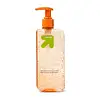What's inside
What's inside
 Key Ingredients
Key Ingredients

No key ingredients
 Benefits
Benefits

 Concerns
Concerns

 Ingredients Side-by-side
Ingredients Side-by-side

Water
Skin ConditioningSodium Laureth Sulfate
CleansingGlycerin
HumectantCocamidopropyl Betaine
CleansingAcrylates Copolymer
Parfum
MaskingMannitol
HumectantPhenoxyethanol
PreservativeMenthyl Lactate
MaskingCellulose
AbsorbentDisodium EDTA
Methylparaben
PreservativeMenthol
MaskingPropylparaben
PreservativeTocopheryl Acetate
AntioxidantEthylparaben
PreservativeSodium Hydroxide
BufferingSodium Ascorbyl Phosphate
AntioxidantRetinyl Palmitate
Skin ConditioningHydroxypropyl Methylcellulose
Emulsion StabilisingAcrylates/Ammonium Methacrylate Copolymer
Triethyl Citrate
MaskingCucumis Sativus Fruit Extract
EmollientCitrus Grandis Fruit Extract
AstringentPanax Ginseng Root Extract
EmollientZingiber Officinale Root Extract
MaskingIron Oxides
Titanium Dioxide
Cosmetic ColorantMica
Cosmetic ColorantTalc
AbrasiveWater, Sodium Laureth Sulfate, Glycerin, Cocamidopropyl Betaine, Acrylates Copolymer, Parfum, Mannitol, Phenoxyethanol, Menthyl Lactate, Cellulose, Disodium EDTA, Methylparaben, Menthol, Propylparaben, Tocopheryl Acetate, Ethylparaben, Sodium Hydroxide, Sodium Ascorbyl Phosphate, Retinyl Palmitate, Hydroxypropyl Methylcellulose, Acrylates/Ammonium Methacrylate Copolymer, Triethyl Citrate, Cucumis Sativus Fruit Extract, Citrus Grandis Fruit Extract, Panax Ginseng Root Extract, Zingiber Officinale Root Extract, Iron Oxides, Titanium Dioxide, Mica, Talc
 Reviews
Reviews

Alternatives
Ingredients Explained
These ingredients are found in both products.
Ingredients higher up in an ingredient list are typically present in a larger amount.
Methylparaben is a preservative and is a paraben. It is used to prevent the growth of fungus, mold, and other harmful bacteria. Parabens are chemicals used as preservatives in both cosmetics and food.
Methylparaben can be synthetically created. It can also be found naturally in some fruits, such as blueberries.
Oftentimes, Methylparaben is combined with other parabens to help increase the shelf life.
The safety of Methylparaben is currently being studied. While ongoing studies are looking into the safety of parabens, the results have been very mixed. Some studies have not found Methylparaben to be harmful.
Learn more about MethylparabenPropylparaben is a preservative and is a paraben with antifungal and antimicrobial properties.
This ingredient can be naturally found in plants and insects, but most of it is synthetically manufactured for human use. In cosmetics, it is usually created by reacting para-aminobenzoic acid and propanol (an alcohol).
You can usually find this ingredient in water-based products.
Parabens have come under controversy due to the claim they are hormone disruptors. Studies show conflicting results. We recommend speaking with a professional if you have any concerns.
Propylparaben is commonly found in food, medicine, and cosmetics.
Learn more about PropylparabenWater. It's the most common cosmetic ingredient of all. You'll usually see it at the top of ingredient lists, meaning that it makes up the largest part of the product.
So why is it so popular? Water most often acts as a solvent - this means that it helps dissolve other ingredients into the formulation.
You'll also recognize water as that liquid we all need to stay alive. If you see this, drink a glass of water. Stay hydrated!
Learn more about Water